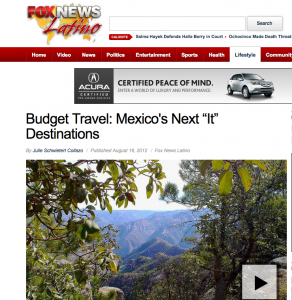Budget Travel: Mexico’s Next “It” Destinations

Budget Travel: Mexico’s Next “It” Destinations
“People think they know Mexico, but they don’t,” says Gloria Guevara, Mexico’s Secretary of Tourism. “Mexicans don’t even know Mexico.”
Though the resort towns of Mexico’s Pacific and Caribbean coasts are frequently visited by Americans, most of the country’s interior—all 1,220,610 square miles of it—is barely on travelers’ radar screens. Lack of awareness about Mexico’s vastness and its diverse geography are two of the most persistent challenges the country faces with respect to tourism.
In recent years, tourism officials have tried to respond to those challenges in many ways, from emphasizing overlooked destinations in its “Mexico: The Place You Thought You Knew” ad campaign to meeting with US Department of State officials to advocate for greater geographic specificity and political context in its travel alerts about Mexico.
The expansion of the Pueblos Magicos program, established to spur domestic travel, which accounts for 85% of tourism in Mexico, has also drawn travelers to places that are less well-known than Cancun and Los Cabos. The majority of the Pueblos Magicos—which are so named because they possess unique symbols, legends, history, important events that convey Mexican history—is located in the interior.
From the coasts to the country’s mountainous interior, here are five up-and-coming destinations to put on your Mexico must-visit list:
Campeche Colonial
Campeche, located on the southeastern part of Mexico on the Yucatan Peninsula offers solid infrastructure for travelers (hotels, restaurants, and typical services), and for those who want to venture into the outdoors, there are rain forest, savanna, and coastal areas in the state (also named Campeche). A colonial fort, multiple sunken ships off the coast, and Maya temples that are taller than Chichen Itza are some of the main attractions in Campeche.
Campeche Catedral
The colonial era buildings in Campeche, including its main cathedral, are protected by law. “The contrast between Campeche’s delightfully languid atmosphere and its vibrantly colored architecture is enchanting,” says Joy Hepp, author of Frommer’s Cancún and the Yucatán Day by Day,. The preservation of these buildings provides for picturesque photo opps and fun small city exploration. Outside central Campeche, there are numerous Maya sites; despite the density of these sites, Campeche is less-visited than the better-known Chichen Itza and Tulum.
Playa Espiritu
Playa Espiritu is being billed as “the next Cancun,” but if that makes you roll your eyes, the caveat is that Playa Espiritu is being built to be 100% sustainable. Cancun was Mexico’s first intentional coastal development, and its successes and failures have served as a template for what to do and what not to do in similarly “integrally planned centers,” destinations that are planned by FONATUR, Mexico’s National Fund for Tourism Development. Located in the state of Sinaloa, Playa Espiritu is a 5,683 acre development that sits on a seven-mile long beach. First hotels are slated to open in 2014, so get there sooner rather than later if you’re not a fan of resorts.
Copper Canyon
The Copper Canyon, a group of six canyons in the Sierra Madre Mountains of the state of Chihuahua, may be Mexico’s most under-appreciated natural attraction. Though you can hike, bike, or ride horses in the canyons, El Chepe, a train that runs along the main canyon, is one of the best ways to get a complete landscape view of the canyons.
Copper Canyon 2
Sylvie Laitre, the director of Mexico Boutique Hotels , says there’s another unique way to see Copper Canyon. Guests of Hacienda de los Santos
, says there’s another unique way to see Copper Canyon. Guests of Hacienda de los Santos , a boutique hotel in Alamos, get a bird’s eye view of the canyon from the seat of the hotel owner’s private plane. Located in the state of Sonora, the Copper Canyon should have the kind of visitors numbers that the States’ Grand Canyon has, but so far, the few visitors who venture here have the experience mostly to themselves.
, a boutique hotel in Alamos, get a bird’s eye view of the canyon from the seat of the hotel owner’s private plane. Located in the state of Sonora, the Copper Canyon should have the kind of visitors numbers that the States’ Grand Canyon has, but so far, the few visitors who venture here have the experience mostly to themselves.
San Luis Potosi
Right in the center of Mexico, north of Mexico City and northeast of Guadalajara, San Luis Potosi has long attracted domestic travelers, who come to the state for the Cave of the Swallows, a 1,200 foot deep sinkhole from which swallows and parrots emerge in a natural flurry of feathers and wings. Perfectly preserved colonial architecture is another major attraction in this old mining town; the town of San Luis Potosi is a UNESCO World Heritage Site and the state of the same name is home to two Pueblos Magicos.
Puebla
Puebla is probably the best known among the five destinations that Secretary Guevara shared with us. After all, it is Mexico’s fourth largest city, and one of Mexico’s most iconic meals—mole poblano—is named after it. Nonetheless, it too is under-visited compared to popular Mexican destinations like Cancun and Los Cabos. Like San Luis Potosi and Campeche, Puebla is a colonial city, characterized by impressive architecture and intense color.
Like all colonial towns, Puebla is full of history, but it’s especially important because it’s here where the Battle of Puebla, a decisive battle in the fight for independence, occurred. The city’s Zocalo, yet another UNESCO World Heritage Site, is a lively, always-busy gathering place for locals and visitors alike, and is an ideal point of departure for either a guided or self-designed walking tour of the town’s main historical sites.
Julie Schwietert Collazo is a freelance writer based in New York City.

